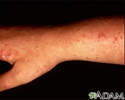Polymorphous light eruption
Polymorphic light eruption; Photodermatosis; PMLE; Benign summer light eruption
Polymorphous light eruption (PMLE) is a common skin reaction in people who are sensitive to sunlight (ultraviolet light).
Causes
The exact cause of PMLE is unknown. However, it may be genetic. Health care providers think it is a type of delayed allergic reaction. It is common among young women who live in moderate (temperate) climates.
Symptoms
Polymorphous means taking on different forms, and eruption means rash. As the name suggests, symptoms of PMLE are rash-like and are different in different people.
PMLE most often occurs in spring and early summer on areas of the body exposed to the sun.
Symptoms usually appear within 1 to 4 days after exposure to sunlight. They include any of the following:
- Small bumps (papules) or blisters
- Redness or scaling of the skin
- Itching or burning of the affected skin
- Swelling, or even blisters (not often seen)
Exams and Tests
Your provider will examine your skin. Usually, your provider can diagnose PMLE based on your description of the symptoms.
Tests that may be done include:
- Phototesting, during which your skin is exposed to special ultraviolet light to check if your skin develops a rash
- Removing a small amount of skin for examination skin biopsy to rule out other diseases
Treatment
Steroid creams or ointments containing vitamin D may be prescribed by your provider. They are used 2 or 3 times a day at the start of the eruption. Steroid or other types of pills may be used for more severe cases.
Phototherapy may also be prescribed. Phototherapy is a medical treatment in which your skin is carefully exposed to ultraviolet light. This may help your skin become used to (sensitized to) the sun.
Outlook (Prognosis)
Many people become less sensitive to sunlight over time.
When to Contact a Medical Professional
Call for an appointment with your provider if PMLE symptoms do not respond to treatments.
Prevention
Protecting your skin from the sun can help prevent PMLE symptoms:
- Avoid sun exposure during hours of peak sun ray intensity.
- Use sunscreen. Sun protection with broad spectrum sunblock that works against UVA rays is important.
- Apply generous amounts of sunscreen with a sun protection factor (SPF) of at least 30. Pay special attention to your face, nose, ears, and shoulders.
- Apply sunscreen 30 minutes before sun exposure so that it has time to penetrate the skin. Re-apply after swimming and every 2 hours while you are outdoors.
- Wear a sun hat.
- Wear sunglasses with UV protection.
- Use a lip balm with sunscreen.
References
Ling TC. Polymorphic light eruption. In: Lebwohl MG, Heymann WR, Coulson IH, Murrell DF, eds. Treatment of Skin Disease: Comprehensive Therapeutic Strategies. 6th ed. Philadelphia, PA: Elsevier; 2022:chap 196.
Patterson JW. Reactions to physical agents. In: Patterson JW, ed. Weedon's Skin Pathology. 5th ed. Philadelphia, PA: Elsevier Limited; 2021:chap 22.
Review Date: 6/7/2023








